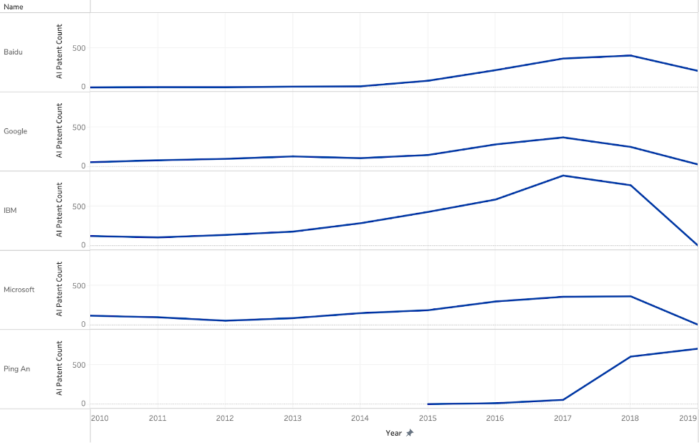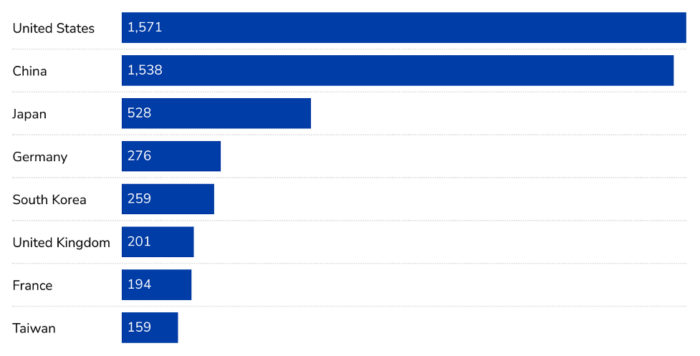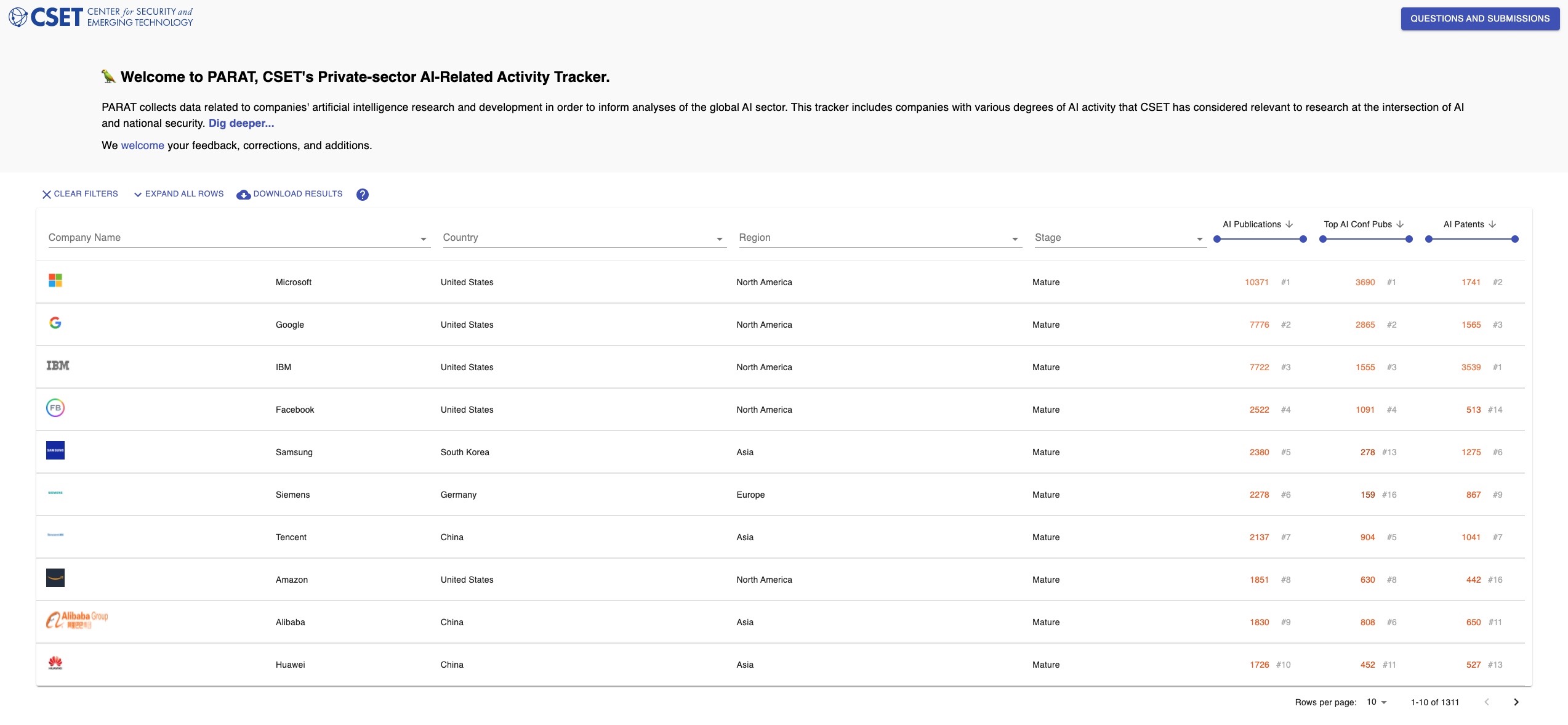In the previous data snapshots, “Using PARAT to Rank Companies by Top AI Conference Publications” and “Where are Companies Publishing AI Papers,” we focused on AI publication output as a way to rank companies included in CSET’s Private-sector AI-Related Activity Tracker. However, PARAT provides yet another method for users to rank and filter companies—by the number of AI-related patents they hold (grouped by patent families).1
Using different metrics, such as total number of publications or total number of patents held, to assess a company’s AI output can lead to different conclusions. For example, a company may focus more on patenting its technology than on publishing research.
PARAT provides yet another method for users to rank and filter companies–by the number of AI-related patents they hold (grouped by patent families).
Counting the patents held by a company provides insight into the quantity and types of innovations that a company has worked on, or is currently working on. Additionally, patents can be a signal of what a company is interested in bringing to market, though there are some “non-market factors” that may motivate inventors to obtain patents.2 Thus, examining the AI patenting activity of companies can be an insightful way of assessing demonstrable AI output.
Within PARAT, users can rank and filter companies by their AI patent output by clicking the arrow next to the column header “AI Patents.” Based on this measure, IBM claims the top ranking, followed in order by Microsoft, Google, and two Chinese companies, Ping An and Baidu. Ping An is a Chinese holding company that handles insurance, banking, and financial services, while Baidu is a Chinese search engine. All five of these companies are categorized as “mature” based on public trading status, number of employees, and/or last funding round.
Figure 1 displays these top five companies’ patenting trends between 2010 and 2019. All five top AI patent-producing companies in PARAT show substantial growth after 2017, though Ping An distinguishes itself from the other top patenters in that it has virtually no patents prior to 2017.3
Figure 1. Patent evolution over time of top PARAT AI patenters

Patent filings for many of these companies appeared to drop in 2019, but that may be attributed to lags in the patent data, and will be refreshed in version 2 of PARAT, scheduled for release later in 2022. The current PARAT interface includes patent filings between 2010 and 2019, with 57 companies having over 100 patents. Of these 57 companies, 33 are based in the United States, 13 are based in China, and six are based in Japan (see Figure 2).
Figure 2. Top PARAT AI Patenters by Country

To better understand which companies are the primary patenters of AI-related technology, we compare the rankings of PARAT companies to that of all companies. To do this, we use CSET’s unified dataset of merged patent data from 1790 Analytics and Digital Science’s Dimensions, which includes all patent filers, not just those included in PARAT. In this analysis, the most prolific AI patenters over the same time period are instead IBM, Baidu, Tencent, Samsung, and the State Grid Corporation of China (China’s state-run utility company). PARAT includes only a limited number of manually selected companies based on multiple AI metrics, only one of which is AI patents.4
When examining top patenters by country in our our unified patents dataset, the United States, China, Japan, Germany, and South Korea remain in the top eight for country affiliations of top AI patenters (including companies, universities, and other institutions) between 2010 and 2020 (see Figure 3).
Figure 3. Top AI Patenters by Country From All Organizations

Within the unified patents dataset, the country counts are more comparable than when only considering PARAT companies, as in Figure 2. This suggests that a large number of non-AI companies based in countries outside of the United States are patenting AI-related technology, as opposed to a more monopolized AI patent market in the United States. However, the outsized role of U.S. companies listed in PARAT in producing AI patents could be attributed to PARAT having more United States-based companies.
One of the significant values of PARAT is that companies are disambiguated: CSET researchers manually annotated subsidiary names and name variations of companies (e.g. “Intel” versus “Intel Corp” versus “Intel Corporation”). This resolution allows a more complete view of how many patents an institution is actually filing, and thus helps remedy a substantial problem when gleaning AI metrics at the organizational level.
Be on the lookout for the next snapshot in the PARAT series, to be posted online in two weeks, featuring more patent data.
- CSET publications typically measure patents using patent families. That is, counting all patent documents in a patent family, including applications and grant documents, as one patent, to avoid double-counting inventions. See Dewey Murdick and Patrick Thomas, “Patents and Artificial Intelligence: A Primer,” (Center for Security and Emerging Technology, September 2020). https://doi.org/10.51593/20200038 for details.
- For the purposes of the snapshot, we refer to patent families as patents. See also Sara Abdulla, “China’s Robotics Patent Landscape” (Center for Security and Emerging Technology, August 2021). https://doi.org/10.51593/20210002.
- Note that PARAT patent yearly counts are determined using application year rather than publication year, as some recent CSET publications have done. For a discussion on this, see Margarita Konaev and Sara M. Abdulla, “Trends in Robotics Patents: A Global Overview and an Assessment of Russia” (Center for Security and Emerging Technology, November 2021). https://doi.org/10.51593/20210012.
- Companies are included in PARAT per user feedback and CSET’s research priorities. For more information, see the Methodology section on the user interface.
